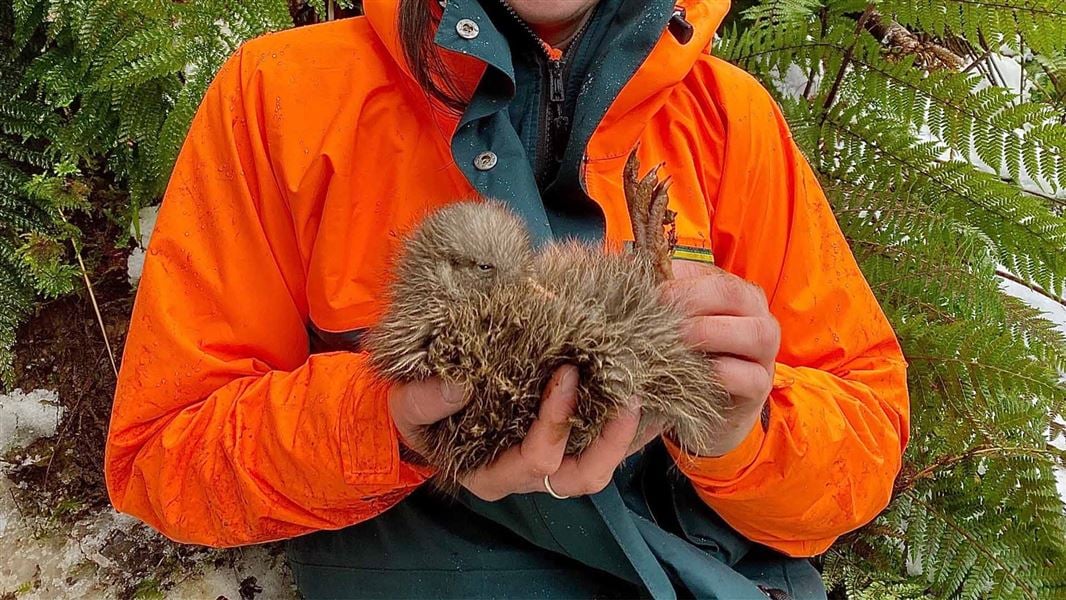
Archived content: This media release was accurate on the date of publication.
Introduction
Kiwi chicks living in a remote part of Fiordland now have a real chance at surviving to adulthood this year, thanks to an effective aerial 1080 predator control operation this past winter.Date: 15 October 2020
Stoat monitoring results following June’s Tiakina Ngā Manu operation at Wet Jacket Peninsulas have shown a significant decrease in stoats – the number one predator of kiwi chicks in the area.
Prior to the predator control operation – the first of its kind in the area, which covered 40,000 ha of public conservation land, 71 of 250 tracking tunnels showed stoats had visited.
Following the 1080 operation, that number was down to zero.
Department of Conservation ranger Tim Raemaekers says this is fantastic news for the resident kiwi population, which has been savaged by stoats for the previous three breeding seasons.
“We’ve been monitoring kiwi chicks at Wet Jacket for the past three breeding seasons and every year it’s the same story. Kiwi chicks hatch, only to be eaten by stoats. Last year, the longest-lived chick only made it to seven weeks old. It’s brutal, and when you extrapolate that figure over the wider area – which also hasn’t previously had any type of predator control, it paints an increasingly grim view for the future of the Fiordland tokoeka kiwi.”
The problem is sustaining the population, Tim says.
“Adult kiwi are a pretty solid match against a stoat. But if hardly any of the new chicks are making it to breeding age, we’ll end up with an increasingly geriatric population, and no new adults to replace them.”
While tracking tunnels are a good indicator, they aren’t perfect, and we expect there will be some stoats that evaded the operation.
“Initially one of the tracking cards appeared as though it could have been visited by a stoat – but it turned out to be a curious kea doing a very thorough investigation.”
A collaboration with Manaaki Whenua Landcare Research at Shy Lake, within the Wet Jacket area, has been investigating whether trail cams can be a more sensitive method for detecting stoats at a low density. Raw figures showed before the 1080 operation there were 162 stoat detections at Shy Lake. After the operation there were just five. This could well have been the same individual stoat as the photos were all within the same small area.
As a comparison, DOC monitored stoats using tracking tunnels outside of the predator control operation zone, but in otherwise similar terrain adjacent to the treated area. The preliminary results showed 100% of the tracking lines were visited by stoats, and of those lines, 78% of the tracking cards within them had stoat prints.
This strongly suggests the predator control has resulted in the drastic stoat reduction at Wet Jacket.
The real proof will be the survival of this year’s kiwi chicks, Tim says.
“You shouldn’t count your chickens before they’ve hatched, and you can’t count your kiwi in the population until they reach adulthood. With the season’s chicks beginning to hatch now, we’ll know for sure in the coming months as we monitor how many make it through the vulnerable chick stage before joining the adult population.”
Sadly, the June operation was not without its challenges, with three monitored kea found dead after the bait application.
DOC operations director Aaron Fleming says the loss of individual kea is always upsetting.
“This highlights the ongoing challenges of conservation in remote, rugged areas. At a population level we know kea do better with 1080 than without but it doesn’t make the loss of individuals any easier,” Aaron says.
However, with this season’s kiwi chicks beginning to hatch and nest cams showing no evidence of stoat visitation so far, all signs are pointing to a positive outcome, Tim Raemaekers says
“We’re off a really good start – our first few monitored chicks have arrived, and so far, we haven’t seen any stoats on the trail cam footage from kiwi nests. This is a huge difference from previous years, when up to 90 % of nests were visited by stoats,” Tim says.
“It’s not the end of the Shy Lake kiwi story yet, but this chapter is certainly the most positive in a long time – it’s looking as though these chicks will have the best chance in decades of survival”
More info
Our work with the Fiordland tokoeka kiwi.
Contact
For media enquiries contact:
Email: media@doc.govt.nz